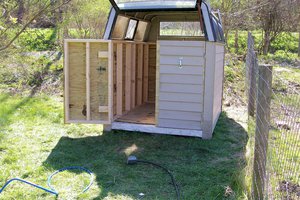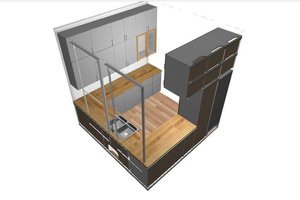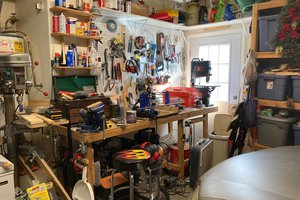My new shop light geometry is 8' long, though you could make it somewhat shorter, 8' works real well. It involves using 10 inexpensive plastic E27 based sockets available on eBay. The last bunch I bought, I was able to get for under $5 for 10 of them. They have went up some. Tariffs no doubt, but still a good deal at under $8 for 10 of them delivered. And you will need 10 8W LED lamps from the Dollar Tree. Oddly eBay nor Alibaba have been able to do better. The 8W (60W) incandescent equivalent lamps at the dollar tree are hard to beat.
You need to include a few pieces. You can screw these right into the ceiling. I have been making strips out of furring strips. I have a sawmill and a wood shop and I have a lot of scraps. I use an upside down T shape out of two of the furring strips, gluing and screwing the vertical part into the center of the horizontal part. This does a good job to jeep the assembly from warping and adds some weight so the lights hang nice. I evenly space the 10 fixtures along the bottom of the T and secure them in with short wood screws, but that is the very last step.
The first step, after obtaining all the stuff and doing some dry fitting to see how things are going to work out is to decide on the spacing of the sockets and figure out how long the power jumpers will be from socket to socket.
Once you have that number, you can sit down and mass produce jumpers. You will need 20 of them. I have a spool of insulated 16 gauge wire a friend gave me. I start with a measured first piece and (make sure you accommodate for about 1/4" stripped off of each end) start a cutting. Once I have the pieces cut from the first piece, I double check to make sure they all look ok, and trim or remake any strays. Than I do the stripping If you have one of the auto strippers and you can set it up to deal with the wire you have and the amount you want stripped you are in great shape. My auto stripper does not do a great job on the wire I have so I wind up having to go over each "cut" with a pair of hand strippers and pull the insulation off with them. After the wire is all stripped I tin all the ends. This is not 100% necessary but it makes life a lot easier in the next step.
Wiring the sockets. I have to admit that I really like the way the sockets retain the wire. It is very easy to slip a wire in under the clamp from both sides and tighten it down. Remember that this is both thin material and from China so if you try you will break or strip something. You do not need to crush the connections.
As I have stated before, I am an awful garbage scow. Whenever I see an old vacuum cleaner roadside I will jump out quick with my cutters and snip the cord off. I already have a collection of old vacs for other parts... After a while you have to be selective!) The old vacuum cords make great extension cords or great cords for the new shop lights.
If you have an old incandescent lamp fixture on a wall switch, you can either tap into it, which is probably against code but it has been done before, or you can procure an E27 to 2 pin socket adapter and screw that into the old incandescent lamp socket and plug the new lights into that.
The new lights are very bright., and easy to hang with screw eyes and string so you can raise and lower them. I have tested them with a Kill A Watt and they consume exactly 80W, which is about the same as the old 2 tube florescent fixtures but you get a *lot* more light. They also come on instantly in both warm and sub freezing weather, and they never hum or flicker or strobe. Also, they are impact resistant. This is nice in a shop where you might be working with something long and or unwieldy and accidentally bump into one of them.
And best of all, they are very economical both in terms...
Read more » matthewkleinmann
matthewkleinmann

 johnowhitaker
johnowhitaker

 David Tucker
David Tucker